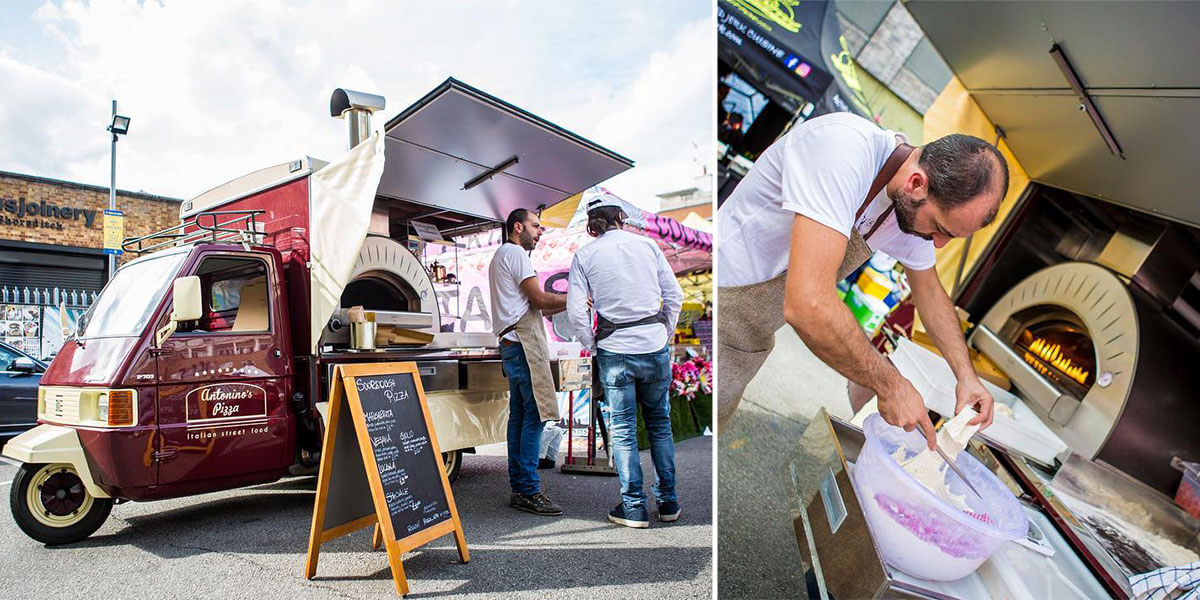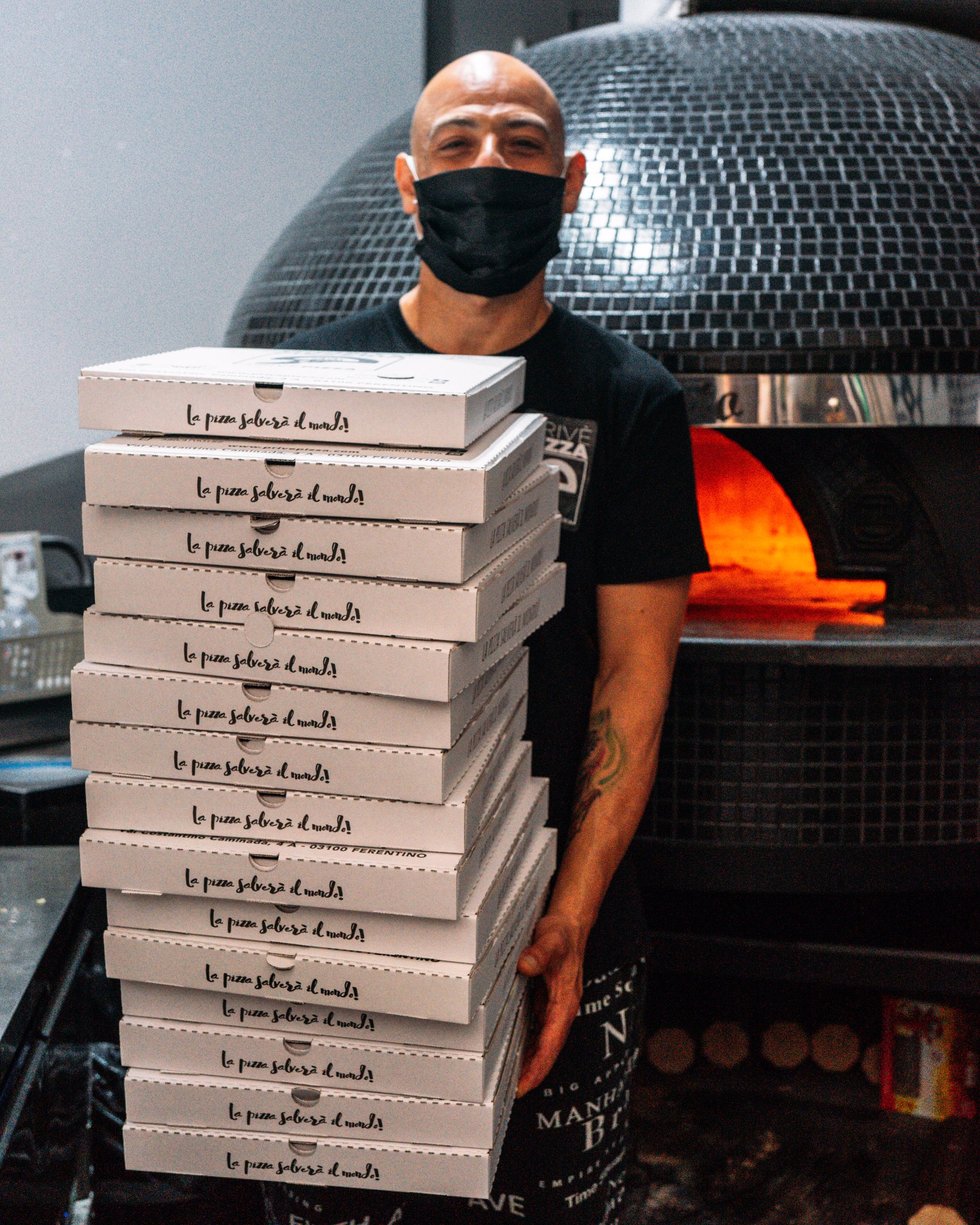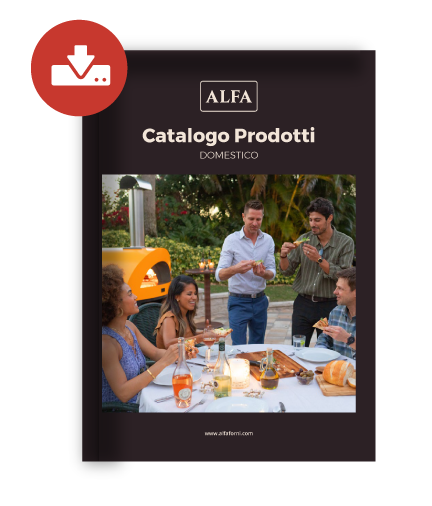FOTO IN COLLABORAZIONE CON: DIPINTO PIZZERIA DI GIUSEPPE PINTO
Restaurants have had to adapt to the changes imposed by the pandemic that caused their dining rooms to close, forcing restaurateurs to work exclusively with takeaways and home deliveries.
Turning your business into a delivery business has proved to be a necessary strategy in order to stay open, and has allowed many businesses to limit the losses caused by closures.
We therefore decided to create this short guide to food delivery, to help restaurateurs (and in particular pizzerias) renew their organisation by including this strategy in an efficient way.
Being able to work best while selling takeaway meals is not only useful for overcoming the difficult time of the pandemic, but above all to bring your business to its full potential and get you ready to reopen once it’s allowed.
We’ll start by discussing order and delivery management, a fundamental process to be able to satisfy many customers. In fact, you’ll have to adapt your business to this new way of working, and there are several ways to do so.
We’ll take a look at different solutions for developing food delivery services, whether with deliveries organised in-house, or by relying on external platforms such as Deliveroo or Justeat.
We’ll then explore how to optimally work with deliveries even in cases where there is little space available, taking advantage of a small and handy professional oven. This discussion is especially important for those business with space issues, such as food trucks or very small kitchens.
We’ll also talk about the importance of digital tools to be able to effectively work with delivery services, which concern both communication and the logistics of restaurants.
Finally, we’ll conclude by summarising the advice provided in this food delivery guide and mentioning the possibilities offered by the range of professional Alfa ovens, which allows every type of business to find the right model for their needs, thus being able to enhance their pizzeria’s food delivery services.
Food delivery guide: how to adapt the pizzeria
Many restaurants, and in particular pizzerias, were already used to providing takeaway food. Before the pandemic, however, in most cases this was an additional sales mode, meaning that it was an add-on to the main business of table service.
In fact, the latter is the real source of income for restaurants, since it is clearly more profitable thanks to the additional fees added for cover charges and especially drinks, as well as the possibility of selling extra dishes such as appetisers, side dishes and desserts in addition to pizzas.
Covid-19 has instead forced everyone to work only (or mostly) with takeaways and deliveries, forcing an entire sector to embrace a trend that was slowly being established in recent years.
Another trend caused by the pandemic that will surely also assert itself in the coming years is to make the most of outdoor spaces, both because of the lower risk of contagion between tables and staff, and because of the lower installation constraints of wood-burning ovens.
Many restaurateurs with outdoor spaces available seized the opportunity to enhance them with an outdoor oven with a design touch which could be seen by customers. In fact, it is possible to find professional ovens with great performance for the outdoor spaces of a restaurant, also smaller in size.
A partly different discussion can be made for pizzerias that sell by the slice, as these serve a product that people eat as street food while walking, or that they take home. This type of work has always been based on takeaways, so this type of business has generally suffered a milder blow from the pandemic than pizzerias or restaurants.
Every restaurant has undergone alternating moments of closures and re-openings, often with little notice, and therefore complicated management of food stock and staff. The closure of dining rooms and the obligation to work only with deliveries or takeaways forced pizzerias to organise their services in order to facilitate both those who make the pizzas and those who deliver them, managing to deliver hot pizzas to customers at the requested times.
In order to be able to work efficiently with takeaways and deliveries, two fundamental factors must be considered:
- Order management
- Delivery organisation
Let’s briefly explore these two organisational aspects, which have always been very important but become fundamental in the current work context.

FOTO IN COLLABORAZIONE CON: DIPINTO PIZZERIA DI GIUSEPPE PINTO
1. Order management
Managing orders well has always been the fulcrum for working efficiently in the kitchen and in pizzerias, both with regard to table service and for integrating takeaway orders with table service.
With a constant or nearly-constant pizza demand, working exclusively in takeaway mode is usually more pressing, since most orders are concentrated in a short amount of time.
Even if this can also be true in relation to table service, in dining rooms it’s easier to manage customer requests according to the needs and rhythms of the kitchen and pizzeria, for example trying to split the orders put in at the same time between those eating pizza first and then other dishes or vice versa.
The lack of table service also requires a much stricter schedule, as customers tend to tolerate less delay in the preparation of their order. Regardless of whether it is delivered at home or picked up, but especially if it’s picked up for takeaway. A slight delay, on the other hand, is usually more tolerated by customers sitting at tables (who can order a drink or an appetiser in the meantime), especially if they see that the other tables are full and that the pizza chefs are busy.
In order to efficiently manage takeaway and delivery orders, it is necessary to try not to accumulate too many pizza orders in just a few minutes. An effective method can be to manage customer requests to find yourself cooking pizzas as gradually as possible, staggering orders every 10 or 15 minutes and trying to book the same number of pizzas in each time frame.
Finally, you must also consider the time necessary to deliver the pizzas, anticipating the schedule by a few minutes.
2. Delivery organisation
Now let’s move on to the second fundamental aspect to consider in order to work well during the pandemic, namely taking advantage of delivery services. To do this, you must first choose between:
- In-house delivery management
- Delivery through external apps
Let’s briefly take a look at what changes between the two different delivery methods.
In-house delivery management
If a pizzeria includes deliveries among its services, this allows to manage customers internally, highlighting the brand and avoiding the competition that populates delivery apps.
Efficiently organising deliveries in-house can be complicated, and in order to keep costs low, it’s necessary to properly calculate both the earnings on individual pizzas and the transport costs (the vehicle and the person).
Another factor to consider is the range of action, meaning the maximum delivery distance. In fact, once a certain limit has been exceeded, it is no longer worthwhile to accept an order (unless it is substantial), both for the increase in transport costs but above all for the long journey times (keeping a driver busy for a long time).
The best way to efficiently manage deliveries is to start with order management. It’s important to have a map of the city right next to the phone, where the deliveries to be made are marked as the requests come in.
The goal is to make multiple deliveries with a single driver, but this is only possible if several orders are close in both time and delivery location (to make sure all the customers receive hot pizza and optimising the routes to be travelled).
Delivery through external apps
Instead in the second case, by basing your food delivery service on external apps, you can work without having to worry about deliveries.
Another great advantage of using these platforms is that they can be reached by a large number of people, depending on your location. In fact, this solution is much more adopted by restaurateurs in large cities, as there many people choose what to eat on these platforms.
However, external delivery management has some negative aspects that should not be overlooked.
The first of these concerns a lower profit margin, since the food delivery app must also receive compensation for each delivery.
The second negative aspect concerns operational management, since you must be ready to satisfy requests even with little notice, a factor that could make things hard if many orders come in at the same time.
The last aspect that prevents many businesses from relying on external food delivery apps relates to marketing, considering that people rely on an intermediary instead of our business. This means that you do not have contact with the customers through these apps and it is therefore very difficult to make them loyal, also due to the high competition that exists within the delivery apps themselves.
Having seen the main differences between the in-house and external organisation of deliveries, you can decide which solution is most suitable in your case, based on where you are and the type of offer presented to your customers.
Managing orders and deliveries in the best possible way is the key to working efficiently with food delivery, as you will be able to optimise times and reduce costs, thus increasing the profit margins of your pizzeria.

FOTO IN COLLABORAZIONE CON: DIPINTO PIZZERIA DI GIUSEPPE PINTO
FOTO IN COLLABORAZIONE CON: DIPINTO PIZZERIA DI GIUSEPPE PINTO
How to turn your business into a delivery business
After having seen how to organise work to adapt to the delivery services imposed by the pandemic, now let’s take a look at how to transform the problem into opportunities, following some strategies aimed at making the most of work with takeaways and home deliveries.
In this section we will offer you some ideas for transforming your business into a food delivery business, which concern two different strategies:
- Two ideas for those with limited space
- The use of digital tools
We will examine two ideal solutions for creating a pizzeria in a small space and taking advantage of delivery services, namely food trucks and ghost kitchens, as well as the importance of some digital tools that are now extremely widespread and which we cannot do without.
1. Two ideas for those with limited space
Turning your pizzeria into a food delivery service means organising work to be able to make a large number of deliveries while trying to optimise costs and increase the average order value.
Pizzerias with a large oven and more than one pizza chef usually manage to satisfy the demand for many pizzas in just a few minutes, depending on the skill of the pizza chefs and based on the oven you use.
Even pizzerias with limited space can, however, satisfy many requests simultaneously, but in this case it is essential to have a professional oven of excellent quality, which does not lose its cooking abilities when it is put under pressure.
Now we’ll take a look at two delivery strategies, namely food trucks and ghost kitchens, two different solutions for those who want to create a pizzeria in a small space, a trend that has been established for some years now.

Food trucks
The travelling pizzeria is in itself a delivery philosophy, which means going to cook directly where many people are located. Covid-19 has had a particular impact on this type of business, emptying the streets of large cities and stopping events, i.e., the places where all kinds of food trucks work.
This is why many food trucks have decided to work with delivery services, both through external apps and organising deliveries in-house. In fact, you only need one person with a driving license and another means of transport, while the pizza chef works in the food truck parked at home.
The beauty of this strategy is that it can be easily replicated even when you move the food truck to work in a normal location, hoping to go back to safely circulating like before as soon as possible.
The main constraint of mobile pizzerias is usually limited spaces, which is why you must focus on small but efficient ovens, able to maintain high temperatures with limited fuel consumption.
Another relevant factor in choosing an oven for a food truck is the weight of the oven (which is usually considerable), as it directly affects the vehicle’s fuel consumption.
The range of Alfa ovens allows you to find professional ovens for compact and lightweight food trucks but with high performance, the perfect tools for a pizzeria on wheels.
Ghost kitchens
A ghost kitchen is a type of restaurant based only on delivery and takeaway services, meaning it does not have a dining room for customer service.
This factor allows you to dedicate all your space to the needs of the kitchen, thus managing to work well even in a few square metres if you choose the right tools and organise everything efficiently.
For this type of business, it is obviously important to offer quality products, but it is also essential to be able to communicate your offer, especially by using digital tools (which we will discuss below).
Ghost kitchens are an organisational solution that best express all the potential of food delivery services, as long as the deliveries are efficiently organised, for the reasons already explained.
2. The use of digital tools
After having seen two solutions for creating a pizzeria in a small space able to take advantage of delivery services, let’s now briefly discuss some tools that can help you further develop this way of working and in general grow your restaurant business.
We also talked about the advantages of digital tools in another article of our blog with some ideas for relaunching a restaurant and standing out from your competition.
In many cases, the various digital solutions have now become fundamental to be able to continuously attract customers, which has led to the start of the digitisation of the food services industry. The pandemic has further accelerated this trend, giving additional importance to the ability to organise food delivery well by offering adequate tools to customers.
After a year of Coronavirus, people now expect to be able to quickly find the menu on your site or on social media and above all to be able to order easily and pay comfortably.
It is now also necessary to provide customers with a wide choice of communication channels and be ready to promptly respond in each of them. Let’s take a brief look at the main digital tools and how to use them to work with food delivery services, namely:
- Your own app and website
- Social networks
- Offers and coupons
- Cashless payments
We’ll take a brief look at each one below.
1. Your own app and website
Having a good website and smartphone app is one of the most used solutions by restaurateurs, because they are spaces that can be freely managed and where you can establish more direct relationships with customers. This factor not only allows you to make communications more personalised, but gives you the ability to use customer data to develop targeted strategies.
To take advantage of food delivery services with your website and app, it can be convenient to organise deliveries in-house, as the digital tools allow to provide a complete experience through your own means, always keeping the customer in touch with your brand, from the order to its delivery.
2. Social networks
Social platforms are now widespread and for this reason they are also used by many companies, including pizzerias.
These tools are extremely convenient because they allow you to instantly dialogue with individual customers, but they are also very useful to communicate your offer and identity to a large number of people.
The first way for restaurants to take advantage of social networks is to present your business in a convincing manner, showing the various aspects of the work, communicating the offer and recounting the restaurant experience.
A good showcase on social media, with contacts in plain sight, can already create a more innovative image of your pizzeria, but it is advisable to try to make the most of the potential of social networks to enhance your food delivery services.
With rather low advertising investments, these platforms not only let you reach a large number of people, but above all let you choose those who are most likely to become customers if they see your message.
You can start experimenting with low costs, but to obtain relevant and constant results many restaurateurs choose to rely on professionals in the sector such as web agencies or freelance professionals skilled in web marketing.
To make the most of food delivery through social networks, an idea that has worked for many restaurateurs during this difficult year has been to make targeted offers based on geographical location, for example offering free delivery to customers within two or three kilometres from the pizzeria (since the costs are limited in terms of time and money, and you clearly want loyal customers in your area).
3. Offers e coupons
The third type of tool we’ll discuss includes sites and apps dedicated to comparing restaurants, for example TripAdvisor. These are sites where your restaurant is reviewed by customers, so that it becomes a test of the quality of your hospitality and good food.
These tools can help you attract many customers, especially if you’re in a tourist city or in any case a city with many people. However, these tools require the intelligent management of reviews, thanking those who leave positive ones and even those who criticise you, inviting them to come back to try the improvement.
Another type of comparison site is those which include offers or discount coupons, such as The Fork or Groupon. These sites let you engage a large number of people attracted by the low price. But it is a double-edged sword, because these people usually tend to leave more mediocre reviews and you work with narrower margins.
You can use these tools to enhance food delivery services, for example by offering free delivery (within certain distances and total bill value), or offering a free pizza every four.
4. Cashless payments
The last tool we’ll discuss is increasingly widespread technology, across all the different platforms used to place and pay for food delivery orders.
It concerns order payment methods, and in particular using solutions that favour electronic money.
It’s true that these platforms take a percentage from your transactions, but it is an extremely convenient service that’s increasingly requested by customers, both at the table and for deliveries.
Many people even prefer to pay for orders in advance when they order it, because they can do it through PayPal or other methods without additional costs and in only a few clicks.
To make the most of food delivery, it is therefore very important to give your drivers suitable tools for cashless payments, giving customers the opportunity to pay by card at home as well.
The digital tools we have seen can help pizzerias have flourishing delivery services, together with an efficient organisation of orders and deliveries.
The current period is ideal for relaunching your business, refreshing your image and modernising the services offered. In doing so, you’ll already have had time to incorporate the changes into your organisation when the situation finally goes back to normal.

FOTO IN COLLABORAZIONE CON: DIPINTO PIZZERIA DI GIUSEPPE PINTO
Renew your pizzeria for delivery services with an Alfa oven
We mentioned the importance of a good oven in a good delivery service, since on average people tend to all order pizzas at the same time. This not only makes it difficult for the pizza chef, but also for not-so-exceptional ovens that struggle to maintain the right cooking temperature for the pizzas.
Thanks to Forninox technologytm, Alfa ovens boast great thermal efficiency, provided by the union of the best refractory materials with the stainless steel vault.
This innovation has allowed us to develop a wide range of high-quality professional ovens, which includes wood, gas and hybrid models (as well as an electric one).
The vast choice of models can guarantee you’ll find the right oven, even if you have very little space, still being able to cook pizzas to perfection and add a touch of design to your restaurant.
Those who want a more manageable, medium-size oven can choose between Opera (capacity of 7 pizzas) or Quick (6 pizzas), while those who have limited space and need a compact oven can consider the Quattro Pro (3 pizzas), equipped with a mobile base, or its version without a base Quattro Pro Top, perfect for food trucks with little space.
Alfa ovens can help you enhance your business’s takeaway and delivery offering, thanks to their excellent performance and ease of use.
This guide to food delivery included numerous tips for enhancing this working method, starting from the management of orders and deliveries, addressing the problem of kitchens with little space and exploring the digital tools to be used for food delivery.
We hope to have been of help to restaurateurs who want to transform their business into a food delivery business, renewing their offer also thanks to a new oven with excellent performance such as the Alfa professional ovens.



